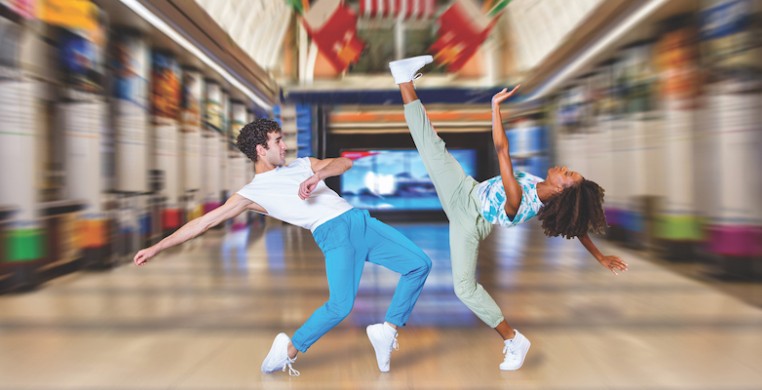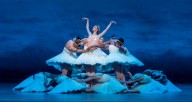The Joffrey Ballet’s “The Times Are Racing” sprints into the 2020 season with four modern stylists setting the pace for the new decade.
Christopher Wheeldon’s “Commedia” (2008), set to Stravinsky’s “Pulcinella Suite," the Chicago premiere of Israeli choreographer Itzik Galili’s “The Sofa” and “Mono Lisa,” Chicago choreographer Stephanie Martinez’s “Bliss!” (2019), and Justin Peck’s “The Times Are Racing” (2017), also a Chicago premiere, comprise a program of widely contrasting mood, style, and music.
The mixed-repertory program runs Feb. 12-23 at the Auditorium Theatre.
“The Times Are Racing” seemed like an apt title for the entire program, according to Joffrey artistic director Ashley Wheater. “It sits really well with this generation,” he said in a recent interview with See Chicago Dance. The “extremely well-crafted choreography provides a depth throughout,” Wheater said, that shows the range of the company.
Israeli choreographer Galili’s duet, “Mono Lisa,” set to the sounds and rhythms of an old typewriter by Galili with composer Thomas Höfs, requires transitions with “no second guessing,” Wheater said. “There is a huge amount of counterbalance.”
“Times,” performed in sneakers to a hyper-kinetic score by Dan Deacon, captures the collective energy of the company, blending tap into Peck’s unique synthesis of traditional and contemporary forms.
Created for The New York City Ballet over a period that spanned the 2016 presidential campaign and election, “Times” unleashes a youthful spirit of protest. “It has a community feel about it that says, ‘We are young, we are energetic, and we deliver!’” Wheater said. Peck is a NYCB soloist, choreographer in residence, and one of four interim company directors following the departure of Peter Martins. The Joffrey is the only company other than NYCB to perform the work.
“What’s exciting and cool and different,” said Joffrey dancer Dylan Gutierrez, is moving in sneakers in Peck’s piece. “You move differently than in ballet shoes,” he said in a recent interview. In “Times,” Gutierrez says, “I’m me. The steps allow you a lot of interpretation. It shows the company in their truest.” While Peck’s movement is strictly set to counts in the music, “it looks like a free-for-all…on a whim, but it’s choreographed. It’s built around tension. (You) let out your demons in a therapeutic, cathartic (way).”
By contrast, his role in a ménage à trois in Galili’s “The Sofa,” set to music by Tom Waits, was “hard to learn at first,” Gutierrez said. While the comedic ballet demands gymnastic athleticism, it's “not super difficult physically. The difficulty is in nuancing, that makes it funny and relatable—so that it’s true.”
The three characters—a straight woman, a gay man, and a straight man—perform the same movements with different coupling. “You have to make it specific,” he said, to tap into both the humor and truth of the role and relationships.
Chicago choreographer and River North Dance Chicago veteran Stephanie Martinez was originally commissioned by the Joffrey for performances of Stravinsky’s “Dumbarton Oaks” with the Chicago Symphony Orchestra at Orchestra Hall. Martinez is a recipient of the Joffrey’s 2014 “Winning Works: Choreographers of Color” award.
Wheater said he is “thrilled” to include “Bliss!” in the Joffrey’s regular season performances.
Martinez was “immediately intrigued by the music,” which she described in an interview as “extremely rich in structure and design.” Initially, she studied the music exhaustively. “I obsessed and listened for a good six months. It felt as important as breathing,” she said.
Research into the history behind the music’s creation revealed its principal players, Robert and Mildred Bliss, and their estate, Dumbarton Oaks, in Washington, D.C. The Blisses commissioned Stravinsky to write the music for their 30th wedding anniversary. Martinez’s launching point was knowing who these people were. “There is a pas de deux, a couple in love, playful,” she said. The loose narrative threads the past with movement that speaks to the present.
Each of the three movements has its own personality. In the first, Tempo Giusto, Martinez describes her movement as “extremely brash and active.” The second, Allegretto, is “abstract, quirky, melancholy,” and the third, Con Moto, is all “man power—prestigious and active; jumps all around.” She wanted to create a vision of “young men out having a good time back then, with the joy of dancing, not too stuffy, but with a sense of prestige and some swag.”
Martinez has expanded the cast from its original Symphony Hall performances to eight men and two women, and retooled it for full staging. Taking her lead from Stravinsky, Martinez investigated different pathways to discover interesting shapes and forms. Strongly influenced by Bach’s "Brandenburg Concerti," “Stravinsky worked in form,” Martinez said, “and then would toss it, go rogue, and then go back.”
Martinez wanted the dancers “to feel like the musical notes.” She asked them to imagine what the music would look like on the floor. Joffrey dancer Brooke Linford was “a huge inspiration,” she said. Martinez asked her to “draw with your body. I don’t want your feet really touching the ground.” Seeking imagery to obtain the movement she wanted, Martinez asked her to “touch the nape of your neck to your calf.”
"I’ve never done anything like this before,” Martinez said, who had not ever worked with Joffrey's main company or created a dance to music selected for her. “It’s one of my favorite things I’ve ever done,” she said. For Martinez, the most fun aspect of creating “Bliss!” was “having the ability to adapt to music outside my comfort zone, and working with these beautiful, talented dancers!”
--
“The Times Are Racing” runs Feb. 12-23 at The Auditorium Theatre, 50 E. Ida B. Wells Dr. Hot deals are available by clicking the event page below.


